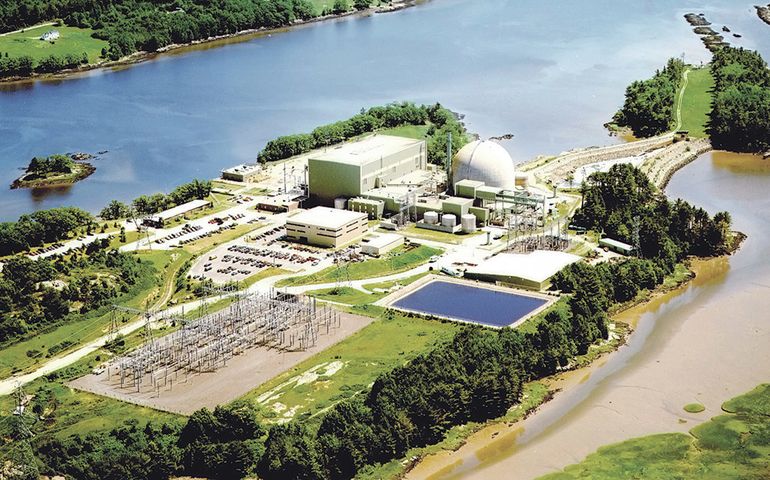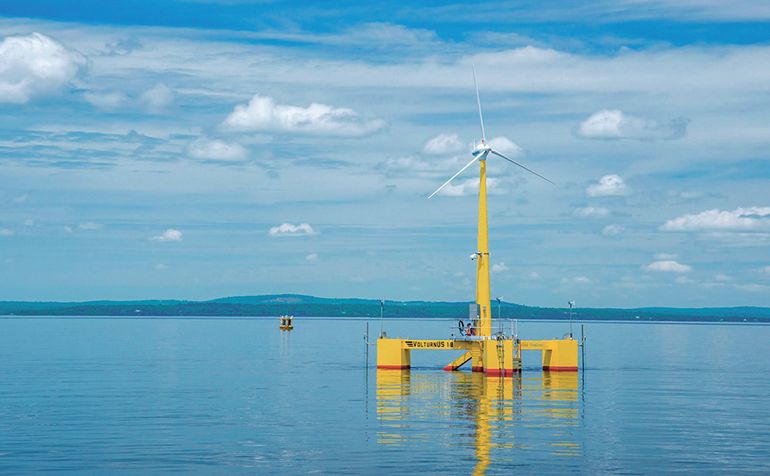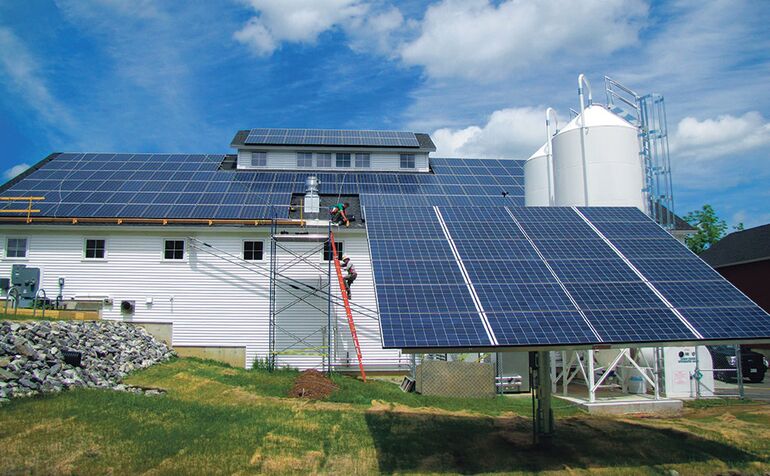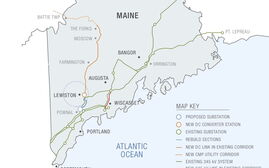
Processing Your Payment
Please do not leave this page until complete. This can take a few moments.
- News
-
Editions
View Digital Editions
Biweekly Issues
- December 1, 2025
- Nov. 17, 2025
- November 03, 2025
- October 20, 2025
- October 6, 2025
- September 22, 2025
- + More
Special Editions
- Lists
- Viewpoints
-
Our Events
Event Info
Award Honorees
- Calendar
- Biz Marketplace
In the past 25 years, renewable energy in Maine moved into the mainstream
 File Photo / Nuclear Regulatory Commission
An aerial view of Maine Yankee, the Wiscasset nuclear plant whose dismantling and decommissioning was completed in 2005.
File Photo / Nuclear Regulatory Commission
An aerial view of Maine Yankee, the Wiscasset nuclear plant whose dismantling and decommissioning was completed in 2005.
 Photo / Jeff Kirlin
Gov. Janet Mills announced that Maine had joined the U.S. Climate Alliance, a bipartisan coalition of 21 states committed to reducing greenhouse gas emissions consistent with the goals of the Paris Agreement.
Photo / Jeff Kirlin
Gov. Janet Mills announced that Maine had joined the U.S. Climate Alliance, a bipartisan coalition of 21 states committed to reducing greenhouse gas emissions consistent with the goals of the Paris Agreement.
 Photo / Courtesy of Maine Aqua Ventus
The University of Maine and Cianbro had a pilot program to test floating wind turbines, like the one shown here on Penobscot Bay.
Photo / Courtesy of Maine Aqua Ventus
The University of Maine and Cianbro had a pilot program to test floating wind turbines, like the one shown here on Penobscot Bay.
 Photo / Peter Van Allen
Maine Beer Co. in Freeport incorporated a solar array into its expansion.
Photo / Peter Van Allen
Maine Beer Co. in Freeport incorporated a solar array into its expansion.
The energy mix of Maine’s power supply has undergone a substantial shift since 1994, when 33% of the state’s net electricity generation came from the Maine Yankee nuclear power station in Wiscasset and another 20% from petroleum-fueled generation.
Maine Yankee’s prominence began to change as the aging nuclear plant, in service since 1972, became increasingly more difficult and expensive to run. In response to allegations of safety problems at the plant, the Nuclear Regulatory Commission started a lengthy investigation in 1995. NRC identified so many problems, Maine Yankee’s owners determined it would be too costly to fix them and decided to permanently shut the plant down in August 1997. The eight-year $500 million decommissioning process was completed in 2005.

Maine’s energy profile underwent a sea-change in the new millennium, spurred by several major drivers:
- Slow-but-steady advances in renewable energy sources and market incentives such as the Regional Greenhouse Gas Initiative (2007) encouraging greater use of clean (i.e. non-fossil-fuel) energy;
- The 2000 deregulation of the two major electric utilities, Central Maine Power and Bangor Hydro, forcing them to sell their power-generation assets;
- The 2008 Wind Energy Act, which set ambitious goals of installing 2,000 megawatts of wind capacity in the state by 2015, 3,000 megawatts by 2020 (with at least 300 megawatts coming from offshore turbines) and 8,000 megawatts by 2030 (with at least 5,000 megawatts offshore).
Although those wind energy goals haven’t been met — Maine had roughly 925 megawatts and 19 operating wind farms by 2018 — wind turbines produce 20% of the state’s net electricity and account for two-thirds of all wind-powered generation in New England.
According to the U.S. Energy Information Administration’s most recently updated profile (based on June 2018 data), almost 85% of Maine’s net electricity generation came from renewable sources, with almost 33% from hydroelectric dams, 25% from biomass generators using mainly wood waste products, and 20% from wind turbines. In addition, almost 20% of net generation came from natural gas. The rest of Maine’s net electricity generation came from petroleum, coal, and solar power, according to the Maine State Energy Profile.
Maine’s largest electricity generating plant, the 827-megawatt William F. Wyman station in Yarmouth, burns No. 2 fuel oil and in recent years has been used only to meet peak power demand in the winter.
According to the U.S. Energy Information Administration, the industrial sector accounts for about one-fifth of Maine’s net electricity generation, the highest proportion of any New England state and one of the highest among all the states. Maine’s industrial sector primarily uses biomass, hydroelectric and natural gas turbines to generate power.
With its limited use of coal and petroleum for electricity generation, Maine is among the 10 states with the lowest carbon emissions, USEIA added.
Looking forward, Gov. Janet Mills announced that Maine had joined the U.S. Climate Alliance, a bipartisan coalition of 21 states committed to reducing greenhouse gas emissions consistent with the goals of the Paris Agreement. Mills said her office would seek to reduce Maine’s greenhouse gas emissions by 26% to 28% by the year 2025 and by 80% by 2050. She also pledged that 80% of the state’s electricity would come from renewable energy by 2030 and 100% by 2050.
“A change is gonna come,” she said in a nod to the 1964 Civil Rights-era song by singer-songwriter Sam Cooke.
Mainebiz web partners
Related Content

The Giving Guide
The Giving Guide helps nonprofits have the opportunity to showcase and differentiate their organizations so that businesses better understand how they can contribute to a nonprofit’s mission and work.
Learn More
Work for ME
Work for ME is a workforce development tool to help Maine’s employers target Maine’s emerging workforce. Work for ME highlights each industry, its impact on Maine’s economy, the jobs available to entry-level workers, the training and education needed to get a career started.
Learn More
Groundbreaking Maine
Whether you’re a developer, financer, architect, or industry enthusiast, Groundbreaking Maine is crafted to be your go-to source for valuable insights in Maine’s real estate and construction community.
Learn more-
The Giving Guide
The Giving Guide helps nonprofits have the opportunity to showcase and differentiate their organizations so that businesses better understand how they can contribute to a nonprofit’s mission and work.
-
Work for ME
Work for ME is a workforce development tool to help Maine’s employers target Maine’s emerging workforce. Work for ME highlights each industry, its impact on Maine’s economy, the jobs available to entry-level workers, the training and education needed to get a career started.
-
Groundbreaking Maine
Whether you’re a developer, financer, architect, or industry enthusiast, Groundbreaking Maine is crafted to be your go-to source for valuable insights in Maine’s real estate and construction community.
ABOUT
NEW ENGLAND BUSINESS MEDIA SITES
No articles left
Get access now
In order to use this feature, we need some information from you. You can also login or register for a free account.
By clicking submit you are agreeing to our cookie usage and Privacy Policy
Already have an account? Login
Already have an account? Login
Want to create an account? Register
Get access now
In order to use this feature, we need some information from you. You can also login or register for a free account.
By clicking submit you are agreeing to our cookie usage and Privacy Policy
Already have an account? Login
Already have an account? Login
Want to create an account? Register











1 Comments